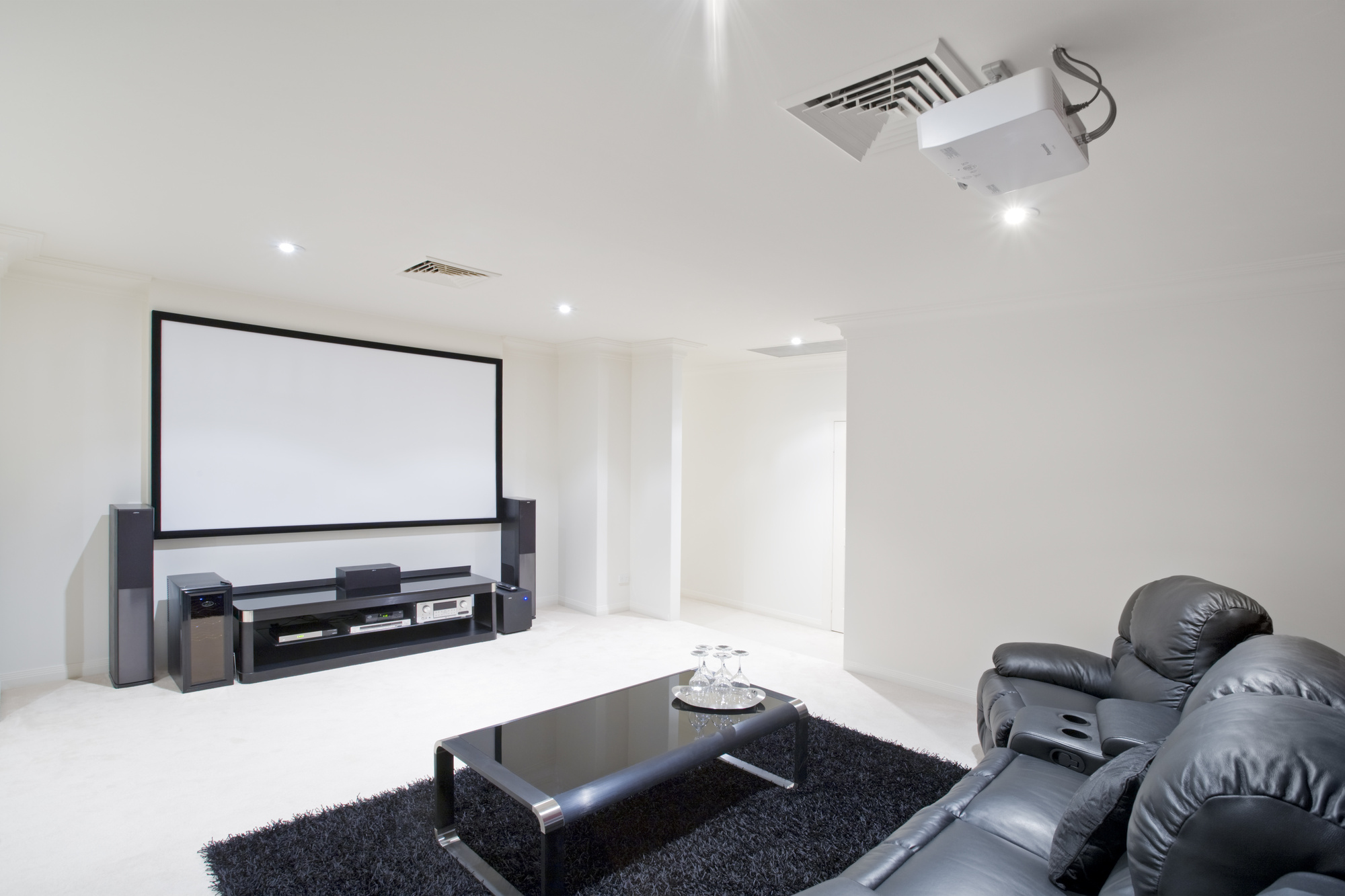Have you been thinking about building a home theater?
Building a home theater sounds fun, but it can be a lot of work that isn’t as easy as you’d think. If you aren’t careful, it’s easy to run into home theater building errors that can ruin your home theater experience.
Don’t let that happen to you. Here are the most common mistakes people make when building a home theater so you can plan your room the right way.
1. Buying the Wrong Size Television
When it comes to home theater building errors, one of the most common ones is buying the wrong size television. Whether it’s too small, too big, or just plain wrong, it can ruin the entire concept of the entertainment space.
Take into account the proximity to home theater furniture, how much seating the room has, and the distance between the seating and the television in order to make sure the television can be viewed comfortably from every spot in the room.
Also, try to imagine the room without the television so you can be sure you’re getting the right size. Finally, read customer reviews and the manufacturer’s specifications to make sure the television is suitable for your needs.
2. The Room Has Windows or Other Light Issues
These can be difficult to incorporate into the design since the goal is to block out all ambient light in order to maximize the theater experience. To prevent these issues, it’s important to limit the amount of natural light entering the room by covering any windows with blackout curtains or other window treatments.
You can also place the home theater equipment, such as the display or speakers, away from windows to further minimize the effect of light interference. Additionally, it’s important to address any electric lighting in your home theater designs that may clash with the desired atmosphere.
You can reduce this by using dimmable lighting fixtures, which give you more control over the intensity and brightness of the space. Finally, be sure to properly adjust the levels and colors of the lights to ensure they match the content being watched. This will provide the best viewing experience.
3. Buying The Wrong Speakers
When it comes to building a home theater, one of the most important decisions that must be made is which speakers to buy. Making the wrong decision here can lead to expensive mistakes.
Some of the biggest errors when buying the wrong speakers are buying speakers that are too loud for the size of the space, buying speakers with a frequency response that doesn’t match the type of sound you like to hear, and buying speakers with a low maximum sound pressure level which will be underpowered for the space.
To avoid these mistakes, it’s important to consider your listening environment and desired sound, research the different types of speakers available, and consult an audio professional if necessary. Additionally, it’s important to read reviews and practice listening to the speakers before making a purchase. This will ensure you get the best speakers for your specific home theater needs.
4. Unbalanced Speaker Levels
One mistake commonly made when building a home theater is having unbalanced speaker levels. Unbalanced speaker levels occur when some speakers are significantly louder than others. Commonly, people experience this issue when one speaker produces a very loud bass frequency.
To prevent this error, it is important to use either a sound level meter or simply use one’s ears to check all of the speakers in the home theater. The speaker levels should all be tested at the same volume and compared against each other.
Additionally, when making adjustments, small increases should be made at a time. This will ensure all speakers are at the desired volume and that no speaker is being overwhelmed. Avoiding unbalanced speaker levels will ensure the home theater’s sound quality is up to par and pleasing to the ear.
5. Not Budgeting For Needed Cables and Accessories
Not budgeting for needed cables and accessories when building a home theater setup can be a costly mistake. Without the appropriate cables, the odds are that the equipment will not be connected properly, causing functionality issues.
Make sure the cables are long enough to reach the correct spots and the right style of connectors is used. The cables should also be the correct version for the device and are of good quality.
Additionally, save some home theater budget for items that may be forgotten, such as mounting brackets, additional inputs and outputs, and surge protectors. Carefully planning and budgeting for the cables and accessories ensure a successful home theater building experience.”
6. Cable and Wire Mess
When it comes to making mistakes in the building of a home theater system, cable and wire mess is one of the most common errors made. It is important to ensure that all cables and wires used for wiring the sound and video of your home theater system are neat and organized.
To do this, it is highly recommended to use a neatly laid out cable management system, such as Velcro straps, to tie up the cables and wires. Also, it is a good idea to buy longer cables than you need, which allows for easier locating of components and rear access to your equipment.
It is also important to test connections to make sure they are correct and secure. Taking the time to properly organize cables and wires ensures a pleasant viewing and listening experience for everyone involved.
7. Not Reading the User Manuals
When it comes to building one, not reading the user manual can lead to errors that can be costly. It’s important to take the time to familiarize yourself with the instructions and understand what you need to do to set up the theater correctly.
Doing a trial run and testing out how the components fit together can help pinpoint any problems before beginning the build. Spending adequate time on the user manuals will not only increase the chances of success, but it can also save time and money.
Knowledge, patience, and precision are all required to properly assemble and maintain the home theater system. Reading the manual properly is the most effective way to avoid errors when building a home theater.
8. Buying by Brand or Price, Instead of What You Really Want
When attempting to build a home theater system, buying by brand or price instead of what you really want can lead to many costly mistakes. Instead of just going off of what is most popular or what is cheapest, it is important to do your homework and research what components are best for your needs.
Investing in the proper pieces upfront instead of making hasty decisions may save you time, money, and energy in the long run. Understand which features work best with your equipment and ensure the components you buy will all sync together as part of a cohesive system.
A proper home theater setup is about much more than what kind of brand name or price tag is attached to it. Put in the effort to find what will best deliver the results you are looking for.
9. Not Buying a Service Plan on an Expensive or Large TV
Building a home theater can be a costly endeavor, and not buying a service plan for an expensive or large television can be a costly mistake. Most televisions come with a standard manufacturer’s warranty; however, these warranties typically don’t cover parts or labor for repair or accidental damage.
If you decide to bypass a service plan for your expensive or large television, ensure that you carefully read the manufacturer’s warranty coverage and make sure you understand exactly what is covered and what is not covered.
If you experience a lot of power outages or live in an area with thunderstorms, consider enrolling in surge protection. Furthermore, consider keeping the original packaging and storing it in a safe place for future moves.
10. Not Getting Professional Help When You Need It
If you don’t properly plan your equipment, components, and layout, you could end up with a system that isn’t up to your expectations. One of the most common mistakes people make when building a home theatre is not getting professional help when they need it.
This can lead to costly mistakes in terms of purchasing the wrong equipment, wiring not being installed correctly, and not getting the most out of your investment. When building a home theatre, it’s important to see these home theatre specialists when selecting components and equipment, especially for the installation of wiring and testing of the system.
Working with a professional will ensure you get the best experience from your home theatre. They can suggest components and equipment that work together, provide the best wiring options, and explain the correct placement for components and speakers.
Read More About Home Theater Building Errors
Overall, home theaters can be rewarding, but it’s important to be aware of the potential home theater building errors and how to avoid them. Check labels and manuals for any product information, and take measurements multiple times.
If you find yourself having difficulties, reach out to an expert for advice.
Did you find this article helpful? Check out the rest of our blog for more!









